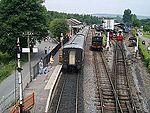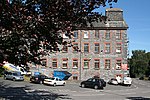River Mardle
Dart catchmentDevon geography stubsEngland river stubsRivers of Devon

The River Mardle is a tributary of the River Dart in Devon, England. It rises on Holne Moor on Dartmoor and flows in a generally south-easterly direction. It forms a short part of the boundary of Dartmoor National Park near its confluence with Snowdon Brook and Chalk Ford, where it is crossed by the Two Moors Way. After this, it flows through Scae Wood and then farmland until it reaches the town of Buckfastleigh where it passes under the A38 road and the South Devon Railway to meet the River Dart near Buckfastleigh railway station.
Excerpt from the Wikipedia article River Mardle (License: CC BY-SA 3.0, Authors, Images).River Mardle
A384, South Hams Staverton
Geographical coordinates (GPS) Address Nearby Places Show on map
Geographical coordinates (GPS)
| Latitude | Longitude |
|---|---|
| N 50.482 ° | E -3.766 ° |
Address
A384
TQ11 0JY South Hams, Staverton
England, United Kingdom
Open on Google Maps











